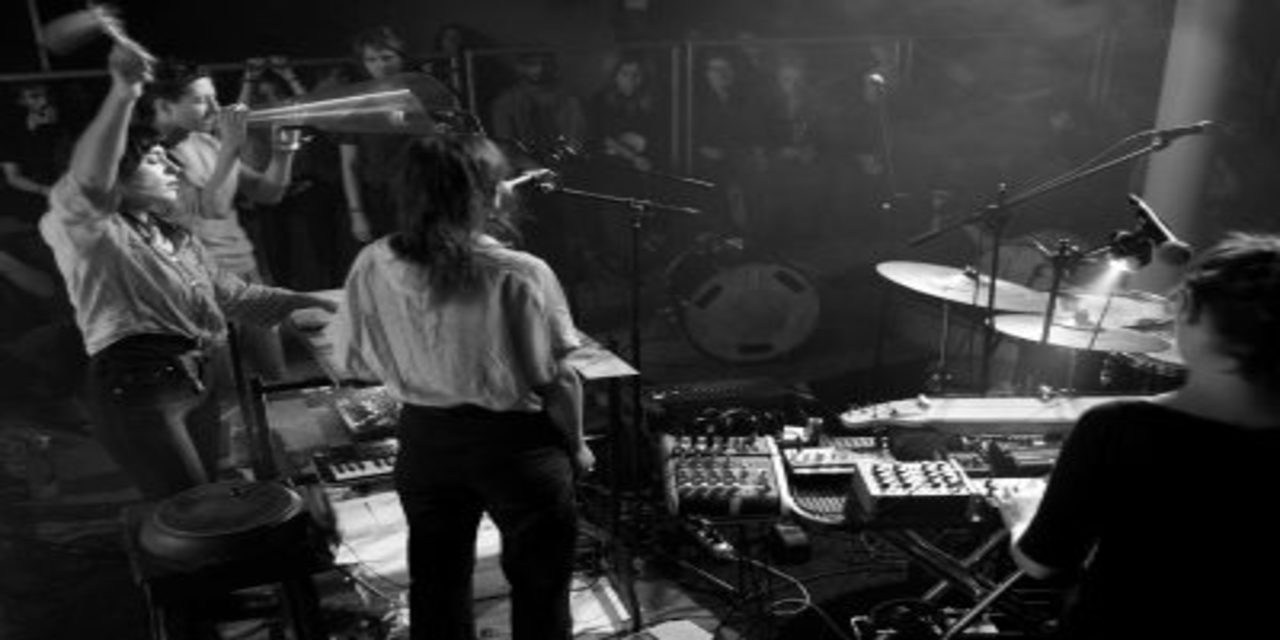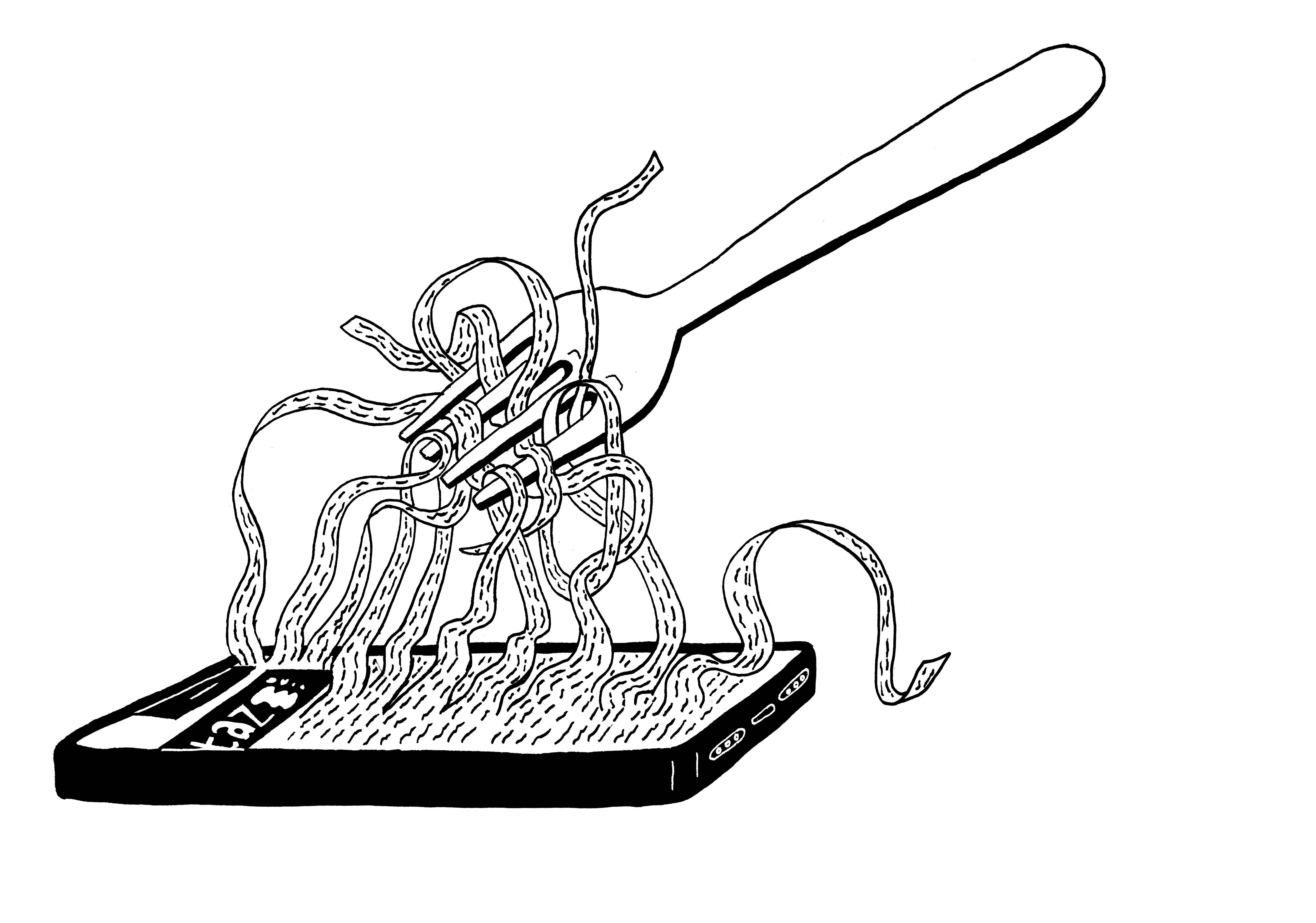I had the privilege to be one of the very few audiences of Seanaps Festival 2020 which took place on October 15-18, in the beautiful venue, Westflügel in Leipzig. The festival sees itself as a homage to life and its sounds, as a vibrant mixtape for curious ears, created in interaction with a global experimental music scene – an intense moment of collective listening. The meticulous curators indeed did a great job in presenting curious artists.
ladr ache played a mesmerising polyphony concert on the third day of the festival. I spoke with the members of the band, Alice, Annabelle, Antonine, Faye, Juliette and Lou about the fluid art of ladr ache.
Merve: The very first thing which caught my attention in your music was that every sound exists so autonomously but also each and every sound is connected in a very collective way. It seems to me, you are not only mashing the versatile musical practices and samples from contemporary music and traditional polyphony but also the various passages of life. How was ladr ache born ?
Indeed! ladr ache was formed very organically. In 2013, at the funeral of a close friend of ours, one of us sang a Russian song, another one of us heard it from the other side of the pavement and sang back to her.
When we’ve experienced violent situations, like the time our squat was evicted by the police, or demonstrations in the street, singing gave us the power we needed.
Actually, we never had the intention to create an only female band, it just happened.
Realizing how healing this way of singing together was for us, we started to make live music together to get organised with political situations, and we finally opened a place to create a music laboratory in Brussels, to rehearse and invite artists we want to support and present to the audience. Since then, we’ve been following the traces of our future together.
Merve: You use among others, samples of baroque, traditional Greek and Georgian polyphonic sounds in your music. And I can imagine you are also inspired by the transcendental sounds like Gnawa music. Can you tell me a bit about how you embodied these contemporary and traditional sounds and created such a personalized sound?
While composing, we never start from Point A to reach Point B. It’s not linear, we create from different sources and materials extracted from personal and collective experiences, songs collected during our travels or international residencies, sounds from our observations of territories, field recordings, literary fictions or everyday interactions.
Our music pieces are more drawn or carved rather than written on partitions. They evolve through an organic way and get woven thanks to the space given to improvisation. It finally produces raw collages.
We work on samples, and we dig deep into decomposing the ones we take from baroque songs or traditional polyphony from Greece, Georgia and Hungary. We keep these samples somewhere in our minds and remember them at some point.
When we rehearse, one sample pops up in our mind, it slips into other sound layers, sometimes into one of our voices and takes more and more amplitude. Then we realize we can use this sample here and now.
Sometimes, one improvisation is enough, but most of the time it’s quite long for us to create a new piece of music. We can see music as a field of forces that translates what we convey individually and tells what our energies draw up together; a story written gradually with lines, contradictions, slippages, shifts and twists.
Sometimes the impulsion of a techno music element arises, one of us embeds a rhythmic woodstick into it, which makes another one react with a looped sentence, that inspires the others to build a polyphonic counterpoint, evolving into a drone… We are like a compost of archives or a big pot of soup.
The oral transmission and traditional inspiration our music takes its roots from, led us to reflecting the dichotomy between the traditional and the contemporary worlds. By travelling and working on how these antique, even archaic, sources can become contemporary, and on how contemporary music contains a traditional part, we’ve realised that what we find interesting through this articulation is the way music can give access to different dimensions and realities by modifying the state of consciousness. Therefore, the contradiction between antiquity and modernity takes another look as it points out how the occidental vision reduces, channels and exploits the forces and the strengths through capitalism.
That’s why we are interested in exploring the link between repetition in traditional music and the one that is woven by industrial or minimalist serial music. The trance question, vocal or rhythmic loops, and the way variations evolve slightly throughout time and duration are at the core of our musical project.
To nourish our music and to learn new approaches, we travel together sometimes. Last year we attended a Gnawa workshop in Meknès, Morocco, in the house of a Gnawa musician maalem (a Maalem is a Gnawa ‘master’). In Gnawa music, there are only two fundamental rhythmic patterns, played with the qraqaibs, but you have to groove it a lot, and it gets to be progressively transformed with the speed, the accents being enhanced. It’s the magic side of rhythm, and a way to create a trance’s state.
In the Kerasovo village in Greece, in 2015, a female musician was giving a workshop on the polyphonic sound of the mountains in this Epirus region, very close to Albania. We learned from her practices as well.
From all these influences, it’s always a question of alchemy for us to find out how not to fall into a category. To avoid falling into the traditional category nor into the minimalist category, we compose from a set of materials that sometimes mesh well together and sometimes fight with each other. That’s how we stay on the edge, and are all the time working on personalizing and fictionalizing our music.
Merve: Were the songs you played at Seanaps Festival your compositions or did you interpret already existing polyphonic songs?
The first song we sang is a Greek song we learned in the Epirus mountains of Greece. We started singing it how it should be, in the traditional polyphonic harmony, but then we took patterns of the song, we looped on it and composed from this pattern basis. We bring it to different directions by layering rhythm, texture, drones…
For example, one song comes from only one sentence and a very small piece of sound of an old Baroque song. We repeat some of the words from the song, but the melody and harmony happens to change completely from the original partition, by developing the vocal pattern into a stuttering and dislocated language.
Our music might be basically like dreams. You remember a true moment of your life and you try to make meaning out of it.
Merve: The architecture and the acoustic of the room must be playing a big role on your sound. Do you also perform outdoors?
Yes we played at outdoor festivals a few times, in a church, a barn, in the woods… but mostly we rehearse in the squat we have for 6 years in Brussels, where we regularly organise concerts and film screenings. We don’t know if the acoustic is actually good in that place, but we feel very comfortable playing there, since it’s ‘’our base’’.
Most of the time we play live as a circle, placing ourselves in the middle of the audience. This circle probably comes from the need to see and hear each other well, and to feel connected. We usually have four speakers surrounding this circle, so the sound is spatial. When we play in a circle, there is also a circulating energy among us because our music is constructed on questions, answers and echoes. We evolve in the music we play. Someone gives a sign, someone else responds to it.
Thanks to the circle live performance configuration, we also hear the sound in the same way as the audience hears it. However, when we play on a stage, we don’t get the chance to hear exactly what the audience is listening to, and it usually creates a big gap between the performers and the audience, not only in terms of feeling but also acoustic.
You can follow ladr ache’s concert announcements here
And listen to their music here.



